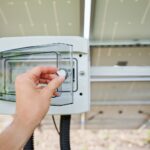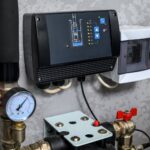Imagine your home’s energy storage system suddenly displaying a series of unfamiliar error codes. These mysterious messages can be daunting, yet they play a crucial role in evaluating your battery’s health and charging efficiency. Understanding these codes is not just about fixing problems; it’s about preventing future disturbances and ensuring your system operates smoothly.
- Decode common error codes in energy storage systems and learn what they reveal about your battery’s performance.
- Discover how certain error codes indicate potential deterioration in battery health and methods to counteract these issues.
- Learn maintenance strategies to optimize charging processes and reduce the frequency of error codes.
- Explore troubleshooting techniques to resolve error codes, ensuring your system quickly returns to normal operation.
Dive into the fascinating world of evolving energy storage technologies and stay ahead with insights into how future advancements will shape error code management, paving the way for more efficient and reliable home energy solutions.
Understanding Home Energy Storage System Error Codes
Decoding the error codes in home energy storage systems is crucial for maintaining effective battery management and overall system efficiency. These error codes serve as a diagnostic tool to alert users to conditions that may affect battery performance and charging processes. Frequent error messages might pertain to voltage discrepancies, temperature issues, or communication breakdowns between different parts of the system.
Being proactive in addressing these error codes can help in identifying flaws in the energy storage system before they escalate into more significant issues. Understanding the specific meanings of these codes not only enhances system reliability but also ensures energy efficiency is optimized. This can prevent unnecessary downtime and extend the lifespan of both the batteries and the entire storage unit.
The Impact of Error Codes on Battery Health
Error codes often signal underlying problems that can lead to battery deterioration. For instance, errors related to overcharging or undercharging can significantly reduce battery life. Consequences of ignored error codes include diminished battery capacity, overheating, or even total failure of the storage system.
Addressing these issues promptly involves understanding their root causes, which can range from environmental factors like room temperature to technical problems such as defective wiring or software faults. Regular maintenance and monitoring of energy storage systems can help prevent these error codes and maintain optimal battery health.
In addition to addressing the immediate problem by interpreting these codes correctly, developing a plan for regular system checks, and firmware updates can further minimize risks. This proactive approach ensures the long-term functionality of energy storage units and supports sustainable energy management at home.
Home Energy Storage System Maintenance: Charging Practices and Error Management
Maintaining your home energy storage system is essential for preventing common error codes and ensuring efficient battery charging. With the increasing adoption of renewable energy solutions, understanding optimal charging practices can make a significant difference in the longevity and performance of your system.
One of the key aspects of proper maintenance is to regularly check the battery’s charge level and cycle the system periodically. This helps in balancing the energy flow and maintaining the battery’s health. Utilizing a smart energy management system can further optimize your charging practices by automating these processes and providing real-time feedback.
Addressing error codes promptly is another vital component of system maintenance. Errors related to charging can often be traced back to issues like overcharging, deep discharging, or temperature-related faults. Implementing a monitoring solution can aid in early detection of these problems, allowing you to corrective actions before they lead to more serious battery degradation.
Additionally, regular software updates for your energy storage system often contain improvements for handling error codes more efficiently. Keeping your system’s firmware up-to-date helps in minimizing the chances of encountering persistent issues.
By integrating these maintenance strategies, you can not only enhance your system’s performance but also contribute to better energy efficiency at home.
Troubleshooting Error Codes in Home Energy Storage Systems
Troubleshooting error codes in home energy storage systems requires a systematic approach to identify and resolve the root cause of each issue efficiently. The first step in any troubleshooting process is to document the error code and consult the system’s manual or the manufacturer’s website, where detailed explanations and suggested solutions can usually be found.
When dealing with battery-related error codes, check for any visible signs of wear and tear, such as swelling or leakage. These physical symptoms can provide clues about the underlying problems. Ensure all connections are tight and corrosion-free, as loose connections can cause unexpected errors.
Some error codes may relate to software glitches rather than hardware faults. In such cases, rebooting the system or performing a factory reset might resolve the issue. However, always backup important data before proceeding with these steps.
If the problem persists, consider using diagnostic tools that are compatible with your energy storage system. These tools can run deeper checks, providing insights into battery performance and any deviations from standard operation.
Finally, when your troubleshooting efforts do not yield successful results, contact a certified electrician or the system’s support service for professional help. A prompt and accurate diagnosis can prevent further complications and restore your system’s efficiency rapidly.
Future Trends in Home Energy Storage and Error Code Management
As the demand for efficient home energy storage systems continues to rise, emerging trends in energy storage technologies are playing a crucial role in shaping the future of smart energy management. By understanding these trends, homeowners and industry professionals can better anticipate and adapt to advancements that promise to minimize error frequencies and enhance system reliability.
One of the prominent trends is the rapid development of lithium-ion battery technology. These batteries offer higher energy densities, longer life spans, and increased efficiency compared to traditional storage solutions. Enhanced battery management systems (BMS) are increasingly equipped with advanced error code diagnostics, helping in the quick identification and resolution of issues, thus optimizing overall system performance.
Another key trend is the integration of artificial intelligence and machine learning in home energy storage systems. These technologies analyze energy usage patterns and predict potential problems, facilitating proactive error management. By anticipating error conditions, AI-driven systems can initiate corrective actions before issues escalate, improving system uptime and user satisfaction.
Furthermore, the adoption of cloud-based monitoring platforms is gaining momentum. These platforms offer real-time insights into system performance and instantly alert users to any anomaly in battery health or charging processes. The integration of cloud-based solutions allows for remote troubleshooting and software updates, reducing the need for on-site interventions.
Future advancements in communication protocols like IoT (Internet of Things) are set to enhance interoperability among various home energy systems. This connectivity ensures seamless data exchange and more accurate error code reporting, enabling more precise diagnostics and effective management of the storage systems.
By staying informed about these cutting-edge trends and technologies, users can ensure their home energy storage systems remain efficient and less prone to errors. Keep an eye on technological innovations that continue to revolutionize the way energy systems are managed, paving the way for a more sustainable and energy-efficient future.
Frequently Asked Questions about Home Energy Storage System Error Codes
What are home energy storage system error codes?
Error codes are specific numeric or alphanumeric codes displayed by your energy storage system to indicate a problem requiring attention.
How do error codes affect battery health?
Certain error codes reflect issues that can deteriorate battery health if not addressed promptly.
Why is my energy storage system not charging efficiently?
Inefficient charging may be due to unresolved error codes signaling power or connectivity issues.
How can I fix error codes in my energy storage system?
Troubleshooting includes checking system connections, inspecting batteries, and consulting your system’s manual for specific steps.
What maintenance practices prevent error codes?
Regular maintenance such as cleaning connectors, updating software, and ensuring proper ventilation helps prevent errors.
Are there any trends in error code management?
Future trends involve smarter diagnostics and AI integration to predict and minimize errors.





